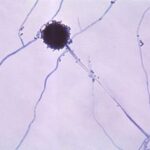Mold is a common occurance. It grows in all of the obvious places such as those with a water source but it can also grow in places that people don’t realize it can grow. These are places such as closets, foam pillows and even your garbage can. A few dozen types of molds cause allergic reactions; these are Alternaria Cladosporium (Hormodendrum), Aspergillus, Penicillium, Helminthosporium, Epicoccum, Fusarium, Mucor, Phizopus and Aureobasidium (Pullularia) being the main types of mold that cause allergic reactions in people.
If someone has a family member with an allergy to pollen or animal dander they are more likely to develop a mold allergy. People with mold allergies can also have an allergy to dust mites, pollen or other spores in addition to the mold allergy. They can have the mold allergy along as well. Farmers, people that work in dairies, greenhouses or winemakers and those that repair furniture are among those that have an increased risk of a mold allergy.
Sneezing, a chronic cough, runny nose and nasal congestion often thought to be colds are symptoms of mold allergies. A mold allergy will also cause your eyes to become itchy red and watery. On the skin a mold allergy will present itself as a rash or in the form of hives. An allergy to mold is also contributed to sinus headaches, reduced lung capacity and difficulty breathing.
Some mold such as Black mold can be toxic even deadly to small children that have an allergy to mold. In homes where foam board was used as insulation that does not allow for the walls to breath the allergy is reaching epidemic proportions. The symptoms of a toxic mold allergy are more severe than other mold allergies.
Coughing up blood, nose bleeds, dizziness, nausea, vomiting and diarrhea are all symptoms of a toxic mold allergy. There is also chest congestion that leads to difficulty breathing. Anemia is also present. A toxic mold allergy can make itself present on the skin in the form of a rash. Forgetfulness and memory loss along with pulmonary hemorrhaging and death have also been associated with toxic mold allergies.
Symptoms may only be present in the summer if an outdoor mold is present but can be present year round if they are being caused by indoor molds. Spores from mold can end up in the nose and lead to hay fever type symptoms. Once in the nose the spores can make their way to the lung which can lead to asthma or a very serious illness know as allergic bronchopulmonary aspergillosis.
The symptoms of a mold allergy may or may not show themselves immediately and will be worse in damp and moldy places.
You are at a higher risk for a mold allergy if one or both of your parents had any allergies, your job constantly exposes you to mold, and your house has a wet basement and/or high humidity. You are also at an increased risk if you live in a newer house since they are made to be airtight in the new efforts for an increased energy savings in homes. They will trap more moisture and are not properly ventilated which are two conditions mold loves and thrives in.
Consult a doctor if you are experiencing any of these symptoms.
Sources:
http://www.theallergyreliefcenter.com/mold_allergy.htm
http://www.allergybuyersclub.com/learning/aafa-mold-allergies.html
http://www.cnn.com/HEALTH/library/DS/00773.html




